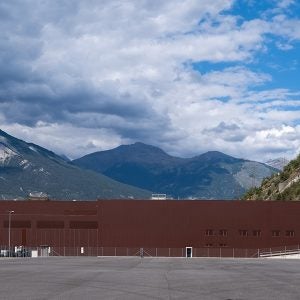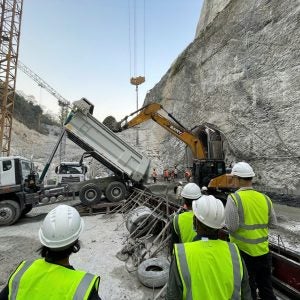THE CONSTRUCTION technology of an RCC arch dam is similar to that of RCC gravity dams. The main difference between these two types of RCC dams is the temperature control and design of joints. Sections of gravity dams are stable on their own, so transverse joints without grouting may be adopted in gravity dams to release the restraint to thermal deformation in the axial direction of the dam. The height of region of remarkable foundation restraint to thermal deformation in the direction of the river is about 0.20L, where L is the width of the base of the dam. Thus, if the concrete of the lower part of the dam subjected to severe foundation restraint is poured in the months of lower temperature of a year, the temperature control of the upper part of the gravity dam is not difficult.
On the other hand, the water loads on an arch dam are transferred to the abutments by the horizontal arch action, the safety of an arch dam relies on the continuity through the dam, and so transverse joints without grouting are not permitted in an arch dam. The thermal deformations are restrained by the foundation rock on the two sides from the base to the top of the dam. If concrete is poured in warm months, remarkable thermal stresses and cracks may be induced in the dam.
There are no transverse joint but only some crack inducers in the first three RCC arch dams constructed in the world ( Kuellpoort and Wolwedans dams in South Africa and Puding dam in China ). After a thorough study of this problem, in 1992, the author pointed out that grouted transverse joints and relevant temperature control generally are necessary to RCC arch dams except the small ones constructed in winter months, and suggested that transverse joints may be made by precast concrete and the dam can be cooled by water flowing in embedded pipes (Zhu 1992).
Thereafter, transverse joints grouted after proper cooling are generally adopted in RCC arch dams in China. The method for computing the temperature loads, the method for control of thermal stresses and the principles for design of joints for RCC arch dams are given in the following paper.
RCC arch dams without transverse joint
In warm regions, such as the south of China, because the final qusi-stable temperature of the dam is high, a small RCC arch dam can be constructed in the winter months. In this case, the temperature drop of the concrete is not great and there will be possibly no cracking if the dam is constructed without transverse joint. It will be shown how to analyse this possibility in the following.
As shown in Figure 1, the temperature in the section of a dam at any time can be divided into three parts: the mean temperature Tm, the equivalent linear temperature difference Td and the nonlinear temperature difference Tn as follows:

(1)

(2)

(3)
where L is the thickness of the dam.
The nonlinear temperature difference Tn is an important factor leading to superficial cracks but it does not affect the displacements and internal forces of the dam, therefore, only mean temperature Tm and equivalent linear temperature difference Td are considered in the stress analysis of arch dam in the Design Specifications for Concrete arch dams in China.
For an arch dam without transverse joints, the temperature loads may be computed by the following formulas

(4)
where Tm and Td are the mean temperature and the equivalent linear temperature difference for computing thermal stresses in the arch dam; Tm0 and Td0 are the highest mean temperature and equivalent linear temperature difference in the process of construction; Tm1 and Td1 are the mean temperature and equivalent linear temperature difference (along x axis) of the annual mean temperature in the period of operation; Tm2 an Td2 are the mean temperature and equivalent linear temperature difference induced by the variation of the water temperature on the upstream face and the air temperature on the downstream face.
As shown in Figure 2, the annual mean temperature of the upstream face of the dam is equal to the annual mean temperature of the water in the reservoir, which can be expressed as follows
(Zhu 1997)

(5)
in which c = ( Tb – bg)/(1 – g ), g = e -0.04H, where y is the depth of water, m; H is the depth of the reservoir, m; Tb is the water temperature at the bottom; b is the annual mean water temperature at the surface of reservoir; Tum is the annual mean water temperature at depth y.
The annual mean temperature of the downstream face of the dam is given by the following equation

(6)
where Tma is the annual mean air temperature, ΔT is the increment of mean temperature of downstream face due to solar radiation. The mean temperature of the downstream face below the tail water may be computed by an equation similar to equation 5.
Because arch dams are generally not very thick, the distribution of annual temperature along the thickness is practically linear, so the mean temperature Tm1 and equivalent linear temperature difference Td1 (along x axis) of the annual mean temperature in the period of operation may be computed as follows

(7)
If no special measures are taken, the distribution of temperatures in the direction of thickness of the dam is generally symmetrical, so the equivalent linear temperature difference

(8)
The maximum mean temperature of concrete in the process of construction is given by

(9)
in which Tp is the placing temperature of concrete, Tr is the maximum temperature rise due to heat of hydration of cement, kr is a coefficient of reduction considering the influence of the compression due to the temperature rise in the early age which will offset a part of the tensile stress induced by the temperature drop in the later age of concrete. kr is approximately equal to 0.70~0.85. To be on the safe side, we may take kr =1.0, then

(10)
Let the adiabatic temperature rise of concrete be given by

(11)
where τ is age o f concrete (d); m is a constant and θ0 is the final adiabatic temperature rise.
For a RCC dam with thickness L, considering the loss of heat from the two lateral sides as well as from the surface of lift, the maximum mean (across the thickness) temperature rise due to heat of hydration may be given by the following formula:

(12)
where N is the coefficient of heat loss from the two lateral sides, given by a theoretical solution (Zhu 1999); s is the coefficient of heat loss from the surface of lift, given by numerical method, the value of s primarily depends on the rate of rising of the dam concrete. N and s may be found from Figure 3 & 4.
As shown in Figure 2, the temperature of the upstream face of the dam is given by (Zhu 1997)

(13)
where t is time; y is the depth of water; Tum(y) is the annual mean temperature of water; Au(y) is the amplitude of annual variation of water temperature; τ0=6.5 month is the time of maximum air temperature; e is the phase difference between the maximum temperatures of water and air; ω=2Π /P, P=12 month is the period of variation of temperature.
Tum is given by Equation 5 and Au is computed as follows
:

(14)
where A0 is the amplitude of annual variation of the water temperature at the surface of reservoir (y =0). The temperature of the downstream face of the dam is given by

(15)
The mean temperature Tm2 and the equivalent linear temperature difference Td2 induced by the annual variation of water temperature on the upstream face and air temperature on the downstream face are computed as follows
:


(16)


(17)
in which

,

,



,

(17a)
where a is the thermal diffusivity of concrete, and P=12 month.
For example, as shown in Figure 5, the height of dam is 75m, the thickness at top is 6m and the thickness at base is 30m. The final adiabatic temperature rise θ0=18°C, the coefficient of rate of heat hydration m=0.15 (1/d), the rate of rising of dam concrete is 0.50 m/d, from figure 4 s=0.89, N is given in Figure 3.
The annual mean air temperature is 14.7°C, the increment of temperature due to solar radiation is 3°C, so the annual mean temperature of the downstream face of dam is Tdm=17.7°C. The annual mean temperature of water at the surface of reservoir is 16.7°C, from Equation 5, the annual mean water temperature at the upstream face of dam is given by

(18)
The amplitude of annual variation of water temperature is

(19)
The temperature loads of the dam are computed by Equations 4, 7, 10, 16 and 17 and the results of computation are given in Table 1.
For the loading case: water pressure + weight + temperature loads in winter, the dam is analyzed by the program ADASO (Arch Dam Analysis System and Optimization) (Zhu et a1. 1991). The stresses are shown in Figure 6. The maximum tensile stress is 1.05MPa, which is less than the allowable tensile stress 1.20MPa, stipulated in the Design Specifications of Concrete Arch Dam of China. Although there is no transverse joint in the dam, as the dam is constructed in winter months, the thermal stresses are small, so it is possible that there will be no cracking. To be on the safe side, some crack inducers may be set up in the dam. It is necessary to use superficial insulation and curing in the process of construction to prevent cracking due to cold wave and drying shrinkage.
RCC arch dams with transverse joints
If the dam concrete can not be poured in winter months, or the dam site is located in a cold region where the final mean temperature of the dam is low, the inevitable big temperature difference will induce remarkable cracking. In this case, it is necessary to adopt transverse joints grouted after proper cooling in the dam.
Firstly, it is suggested to pour the concrete in lower part of the dam in winter months to the greatest extent so as to increase the height H1 of the part of dam without joint as great as possible (Figure 7). Transverse joints are necessary in the part above H1 because the temperature differences are big. As RCC generates less heat of hydration, the distances between transverse joints may be somewhat greater than those in conventional concrete arch dams. According to the length of the crest of dam, there may be 1~4 transverse joints, as shown in Figure 7. Some steel reinforcements must be put beneath the lower end of the joint standing on concrete to prevent the joint from extending downward in the course of cooling of the dam.
Cooling of the dam before joint grouting
Before grouting of the transverse joints, the dam must be cooled to predetermined temperature; for example, the mean temperature of the dam must be not higher than the annual mean temperature of the dam in the period of operation.
This requirement may be fulfiled by natural cooling when the thickness of the dam is small; otherwise, artificial pipe cooling must be used. In Shuikou RCC gravity dam, steel cooling pipe had been used (Chen 1991). In the cofferdam of Dachaoshan dam, a RCC arch dam, PVC cooling pipe had been used successfully (Chen 2002). PVC cooling pipe is more suitable than steel pipe, because PVC pipe has less connections and it is so flexible that it can be installed easily before pouring of concrete.
If the reservoir can be emptied of water in the period of operation, instead of cooling pipe, the repeated grouting system may be used to grout the transverse joints after the dam concrete having been cooled, but there are some uncertainties in this case, for example, if the water level is high in the process of natural cooling of dam, remarkable tensile stresses may appear in the dam which will induce cracking and worsen the stress state of the dam.
Crack inducers
Crack inducers reduce the effective area of the cross-section of the dam. When the tensile stresses in other part are not higher than those acting on the section of crack inducers, they will open; otherwise, cracks may appear in other part of the dam and crack inducers will not open, as in Puding RCC arch dam.
When the dam is thick, a long time is required for the temperature in the dam to fall to the final quasi-steady temperature. Under the simultaneous action of the water pressure and temperature drop in the process of natural cooling of dam, the axial force of the arch is generally compressive (except the upper part of the dam), the stresses will be tensile on one side and compressive on the opposite side, so it is impossible for the full section to open and the stress state in the dam may be worsened.
The action of crack inducers is different from that of transverse joints, which are grouted after the dam having been fully cooled. Thus crack inducers can be used only as auxiliary measures and not as principal measures to control cracking in RCC arch dams.
Construction of transverse joints
The author proposed to use precast concrete to form transverse joints in RCC arch dam (Zhu 1992). This idea was realised and developed in the design of Shapai RCC arch dam (Chen 2002). As shown in Figure 8, the transverse joint is formed by a series of pairs of gravity type precast concrete forms with length of 1.00m and height of 0.30m, which is equal to the thickness of layer of concrete. The height of grouting zone is 6.0m.
There are two types of forms: A1 and A2. The grouting system is installed in form A1 and the keys of joint are in form A2. In the process of construction of dam, the precast concrete forms are installed before the pouring of concrete.
The dam is cut by transverse joints, which are grouted after the dam concrete having been cooled to predetermined temperature. The structural action of transverse joints is clear and reliable.
Conclusions
In the warm region, the final qusi-stable temperature of the dam is high. A small RCC arch dam can be constructed in winter months, so the temperature drop of the dam concrete is not greatand it is possible that there will be no cracking if the dam is constructed without transverse joint.
If the dam cannot be constructed in winter months or the dam site locates in cold region where the final mean temperature of the dam is low, it is necessary to adopt transverse joints grouted after proper cooling of the dam. The joints may be formed by precast concrete blocks with height 0.30m which is equal to the thickness of layer of concrete.
If the dam is thin, it may be cooled to predetermined temperature by natural cooling, otherwise, PVC cooling pipe may be used which is convenient for RCC.
Tables
Table 1






